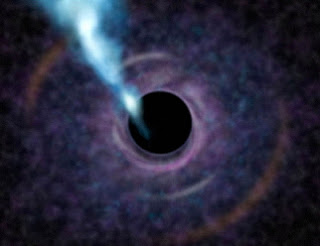

| Visitors Now: | |
| Total Visits: | |
| Total Stories: |

| Story Views | |
| Now: | |
| Last Hour: | |
| Last 24 Hours: | |
| Total: | |
Chet Raymo, “Imagine This”
by Chet Raymo
“At the center of a galaxy 3.5 billion light-years away- one-fourth of the way back to the beginning of time- there is a black hole with a mass 18 billion times the mass of the Sun, so much mass squeezed into so small a space that not even light can escape the pull of its gravity. How do we know it’s there? Around the black hole is a flat whirling “accretion disk” of matter- stars, dust, gas- that glows with fierce energy as it falls into the black hole, to disappear forever. At the heart of the galaxy we see a luminous beacon, a pit of darkness surrounded by a blaze of radiation.
Black holes at the centers of galaxies are not unusual; there is one at the core of the Milky Way Galaxy. But this one, known as OJ287, is the most massive black hole so far known in the universe. And it has an unusual property. Every twelve years it blazes up 100,000 brighter in two bursts just over a year apart. The periodic double flare of energy suggests a companion, another smaller black hole with a mass of 100,000 Suns, orbiting the monster in an elongated orbit, like a comet around our Sun. Every twelve years the smaller black hole plunges through the monster’s accretion disk and out again, splashing matter into the black hole in two bursts of radiant energy. After the paired flare-ups of 1994 and 1995, and the initial flare-up of November 2005, astronomers calculated the orbit of the smaller black hole, and predicted the second flare-up on September 13, 2007. It occurred right on schedule.
And ponder this. The calculation was based on Einstein’s theory of gravitation, which proposes a curvature to apace-time and gravitational waves. Without curvature, the flare-up would have occurred 10 days earlier; without gravitational waves, 20 days later. A stunning confirmation of a theory spun from the great one’s brain a century ago; a test of human genius that reaches one-fourth of the way across the universe.
No dragon, no hippogriff, no pantheon of gods represents a greater stretch of the human imagination than OJ287 and its orbiting companion. The difference? The precise prediction: September 13, 2007. Telescopes around the globe were waiting and watching as OJ287 and its companion performed their cosmic duet exactly at showtime.
What is more mind-boggling? A universe with orbiting black holes at the centers of galaxies? Or a brain the size of a softball that can reach across the light-years to reliably grasp such wonders? If this sort of thing does not make the hairs stand up on the back of your neck, nothing will.”
2012-08-16 23:31:14
Source: http://coyoteprime-runningcauseicantfly.blogspot.com/2012/08/chet-raymo-imagine-this.html
Source:



